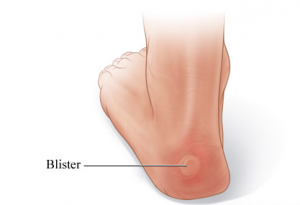 Blisters are small pockets of liquid that form on the outer layer of the skin after the skin becomes damaged and are usually caused by rubbing or burning.
Blisters are small pockets of liquid that form on the outer layer of the skin after the skin becomes damaged and are usually caused by rubbing or burning.
Blisters prevent the area from becoming further damaged by protecting the skin underneath and giving it adequate time to heal.
Blisters are filled with serum, which is essentially blood plasma without fibrinogens. However, some blisters may be filled with blood (blood blisters) – if they become infected or inflamed they can also be filled with pus.
A blister can form on any part of the body, but the most common parts are the feet and hands.
Friction blisters are more likely to develop in skin areas with a thick horny layer held tightly to the underlying structures, such as the soles of the feet or the palms of the hands.
What causes blisters?
There are a number of different reasons why blisters develop. After the skin has become damaged fluid builds up between the the upper layer of the skin and the layers below. Below we have listed the most common causes for blisters.
- Friction or rubbing on the skin – This typically occurs after a long walk, running, or by wearing shoes that do not fit our feet correctly – They can develop quicker if the feet are wet.
- Chemical Exposure – when the skin comes in contact with chemicals found in detergents and solvents blisters can develop. This is also called contact dermatitis. Exposure to certain blister agents, such as mustard gas, can lead to severe and large blisters.
- High temperatures – extreme temperatures can cause first and second degree burns. Blisters that arise from second degree burns typically manifest themselves almost immediately after the skin becomes damaged, whereas those that develop because of first degree burns tend to appear a couple of days after the skin damage. Sun burn is a big cause of this.
- Medical conditions – the most common are herpes, impetigo, dyshidrosis, and chickenpox.
What are the symptoms?
Blisters begin with redness over the spot where irritation is occurring. Eventually, the painful, bubble-like sac appears on the affected area. If the fluid sack is ruptured, they can become infected and begin to form pus. If the infection progresses, red streaks on the skin running upward from the site of the blister indicate cellulitis. If a streak develops or you begin to run a fever, seek prompt medical treatment.
How to Prevent blisters
There are many ways to prevent blisters. Wearing comfortable shoes and using socks that can manage moisture can prevent blisters from developing on the feet, particularly among those who sweat a lot – sport socks help keep the feet dry. Using a protective layer of padding and using a friction management patch applied to shoes also help prevent blisters.
Blisters from chemical exposure can be prevented by wearing gloves.
Blisters caused by sunburn can be prevented if you apply a good sunscreen, wear protective clothing, and limit your exposure.
Treatment for blisters
Although most blisters will heal naturally over time, there are ways to alleviate the symptoms of the pain:
- Cover the blisters with a plaster, gauze pad or dressing
- Hydrocolloid dressings can prevent discomfort
- Apply an ice pack to the affected area right after the injury in order to relieve the pain. Do not apply ice directly onto the skin
- In the case of burns use moisturizing and after-sun or calamine lotions to ease the discomfort.
What to do if the blister bursts
If a blister isn’t too painful, try to keep it intact. Unbroken skin over a blister may provide a natural barrier to bacteria and decreases the risk of infection. Cover it with an adhesive bandage. If you’re allergic to the adhesive used in some tape, use paper tape.
Visit Coastal Urgent Care if the blister is painful or prevents you from walking or using one of your hands. Consider taking the following self-care measures if medical help is not available.
- Wash your hands and the blister with soap and warm water.
- Swab the blister with iodine.
- Sterilize a clean, sharp needle by wiping it with rubbing alcohol.
- Use the needle to puncture the blister. Aim for several spots near the blister’s edge. Let the fluid drain, but leave the overlying skin in place.
- Apply an ointment (Vaseline, Plastibase, other) to the blister and cover it with a nonstick gauze bandage. If a rash appears, stop using the ointment.
- Change the dressing every day. Apply more ointment and a bandage.
